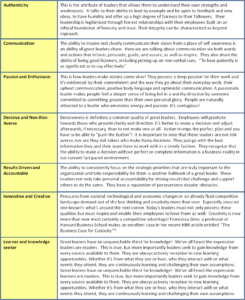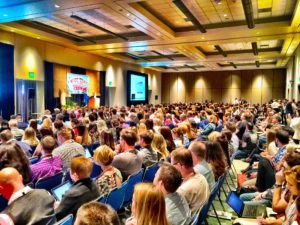How Leadership Development can get you from good to great!
We’ve all read countless articles about what constitutes a great leader. You don’t have to look very hard to get a dozen different viewpoints regarding leadership development. That being said, common themes do emerge. This article offers a first step in the process of moving from good to great on the leadership developmental continuum. But first, a quick recap of the fundamental characteristics that constitute a great leader.
All of the following summarized traits are important, but one stands out above the rest. Which one do you think it is?
Traits of Great Leaders:

Have you considered which trait is the most important yet?
What Elephant!?
Before beginning a more detailed discussion on what the determining trait of a great leader is, let’s first address the elephant in the room. There is an obvious omission in the preceding list that I’m sure you’ve already picked up on. The importance of Organizational Culture is missing! A leader must have the ability to create and nurture that all-important organizational culture; ideally that of a learning culture, but we’ll save that for another discussion. The reason that organizational culture is not listed as a separate trait or characteristic is that it is overarching. It is an element woven into the fabric of the entire leadership canvas, an integral component of all the preceding traits, the common thread! Organizational culture is the linchpin of organizational success. The documentation on the topic is mountainous.
A reference to the learning organizational culture leads nicely into that one trait which many, including myself, consider being the common thread that sets the standard for great leaders. I reiterate; all the above-mentioned characteristics are necessary, however, the Learner and Knowledge Seeker trait is considered to be the most important of them all and here’s why…
Learner and Knowledge Seeker
Great leaders are strong advocates of self-development, both personally and professionally, and actively encourage it in others. They are eager to become better at what they do and how they perform as leaders, as alluded to previously, and are always in self-development mode. These leaders take every opportunity and occasion to absorb knowledge and learn new things. They realize that developing their own capabilities and competencies also benefits their organization as a whole. It goes without saying that they are also continuously sharpening and developing all the above-mentioned traits as well. This is how great leaders keep themselves and their organizations on top and always ahead of the curve.
These leaders are extremely proactive in their quest for knowledge. They not only seek to investigate the area of knowledge that is most relevant to them at any particular point in time but also which method of learning is best suited for that particular subject matter. Let’s take a look at two of the most popular methods and decide which one is more appropriate in the area of leadership development in particular.
The Leadership Development Seminar
 There are countless leadership development training programs out there that will present leaders with a multitude of tools and skill-sets, over the course of a one or two-day seminar format, designed to improve leadership capabilities. One glaring issue with this, despite the logistical sense of cramming all the key learning takeaways into one long training session, is that it greatly restricts learning retention. This is supported by a recent Mckinsey & Company survey** which states that, over time, adults typically retain 10% of what they have heard in a classroom lecture. This is also supported by insights from the fields of neuroscience and psychology, where findings indicate that people don’t truly learn when they are spoken to or even when they perform an activity. It isn’t until they have had a chance to recall and reflect on what they have done that new neural pathways are formed and learning begins.
There are countless leadership development training programs out there that will present leaders with a multitude of tools and skill-sets, over the course of a one or two-day seminar format, designed to improve leadership capabilities. One glaring issue with this, despite the logistical sense of cramming all the key learning takeaways into one long training session, is that it greatly restricts learning retention. This is supported by a recent Mckinsey & Company survey** which states that, over time, adults typically retain 10% of what they have heard in a classroom lecture. This is also supported by insights from the fields of neuroscience and psychology, where findings indicate that people don’t truly learn when they are spoken to or even when they perform an activity. It isn’t until they have had a chance to recall and reflect on what they have done that new neural pathways are formed and learning begins.
Another glaring deficit of this type of training is that there are many different types of leaders with widely varying leadership styles who have a wide range of differing and unique developmental requirements. Can their needs really be adequately covered in a generic group training program?
Most leadership developmental challenges, particularly those at the c-executive levels are often behavioral or perception based. These are issues that will not change overnight, but rather require ongoing effort and reinforcement through continued application, reflection, and feedback. This need is definitely addressed in this learning format. In a recent Forbes article entitled Why Leadership training doesn’t work, Aaron Levy*** argues exactly that point.
“Simply learning what to do over the course of one or two days doesn’t lead to acting differently in the long run”.
– Aaron Levy
He points out that the problem with these types of programs is that most workshops spend 90% of their time in learning mode. Ideally, that proportion of time should be spent on application and reflection mode, including holding short coaching debriefs with the leader to discuss what worked well and what could have worked better. This is not to say that these seminar-type training programs don’t have merit, it’s just that in the case of leadership development, there is a much better way.
Situational Leadership Development via Coaching/Advisory
 This type of learning focuses on the unique needs of the individual leader and their environment. Not to be confused however with personalized or individualized learning, although some commonalities do exist. In this particular type of learning the primary focus is on applying newly acquired knowledge and then reinforcing it in a live setting, ideally with the help of a trusted Advisor (coaching partner). This is the only way to get new knowledge to “stick” in the long run. It doesn’t happen overnight but it is long lasting. This is particularly true in the case of leaders focusing on changing behaviors and/or perceptions. The reflection aspect of learning is an inherent component of what has been coined Double Loop learning; this is what creates the true learning moments that dramatically increase retention. More importantly, it enables leaders to fundamentally alter their patterns of thinking or practices, with the aim of helping them create breakthroughs and learn different things by creating those highly sought after “aha” moments. This again is also supported by insights from the fields of neuroscience and psychology. I will delve more in-depth on this topic in a future article on transformational learning.
This type of learning focuses on the unique needs of the individual leader and their environment. Not to be confused however with personalized or individualized learning, although some commonalities do exist. In this particular type of learning the primary focus is on applying newly acquired knowledge and then reinforcing it in a live setting, ideally with the help of a trusted Advisor (coaching partner). This is the only way to get new knowledge to “stick” in the long run. It doesn’t happen overnight but it is long lasting. This is particularly true in the case of leaders focusing on changing behaviors and/or perceptions. The reflection aspect of learning is an inherent component of what has been coined Double Loop learning; this is what creates the true learning moments that dramatically increase retention. More importantly, it enables leaders to fundamentally alter their patterns of thinking or practices, with the aim of helping them create breakthroughs and learn different things by creating those highly sought after “aha” moments. This again is also supported by insights from the fields of neuroscience and psychology. I will delve more in-depth on this topic in a future article on transformational learning.
Identifying and prioritizing areas for development
As promised, the next step in going from good to great is continuously improving your leadership capabilities. The big question is; how to identify what needs to be improved, or better yet, what are your developmental gaps?
A very effective methodology, and one which I have employed on countless occasions, is our proprietary ‘Catalytic Leadership Development Framework”. A quick summary of this situational development framework is as follows:
It begins with a 360° feedback assessment. This involves getting feedback, both vertically from direct reports and your boss, as well as horizontally from the peers you work with in other areas of the organization. This has proven to be a very effective way to identify where you, as a leader, excel and have opportunities for development. I have witnessed many leaders who have been surprised by the behavioral or perception based gaps identified by this method that they didn’t even know they had.
These 360° results coupled with any one of a number of other individualized personality and/or thinking style assessments create valuable inputs into creating a specific and personalized development plan. One which is custom tailored for your unique developmental needs as a leader, focusing primarily on the application and reflection element of real-time situational learning.
Thank you very much
As a thank you for reading and commenting on this article, here is another great leadership tool as a bonus!
As part of the leadership developmental advisory process at PGR Consulting Group, I work with Leaders to develop a one-page “Leadership Dashboard” at the outset of many of our engagements. Leaders use this simple yet highly effective tool as a way of tracking progress and opportunities, particularly when feeling overwhelmed. It helps them and their team get grounded and focused on what really matters. In one page it captures eight key areas that every leader needs to consider. Throughout the advisory engagement, we regularly check in to see that we’re on track and make adjustments if necessary.
The best way to understand the difference the Leader’s Dashboard can make is by trying it for yourself. I invite you to get a copy of the Leader’s Dashboard by clicking here.
*Francesca Gino, The Business Case for Curiosity, HBR, Oct. 2018
**Pierre Gurdjian, Thomas Halbeisen, and Kevin Lane, McKinsey Quarterly – January 2014
***Aaron Levy, Why Leadership Training Doesn’t Work, Forbes, Feb 23, 2018
